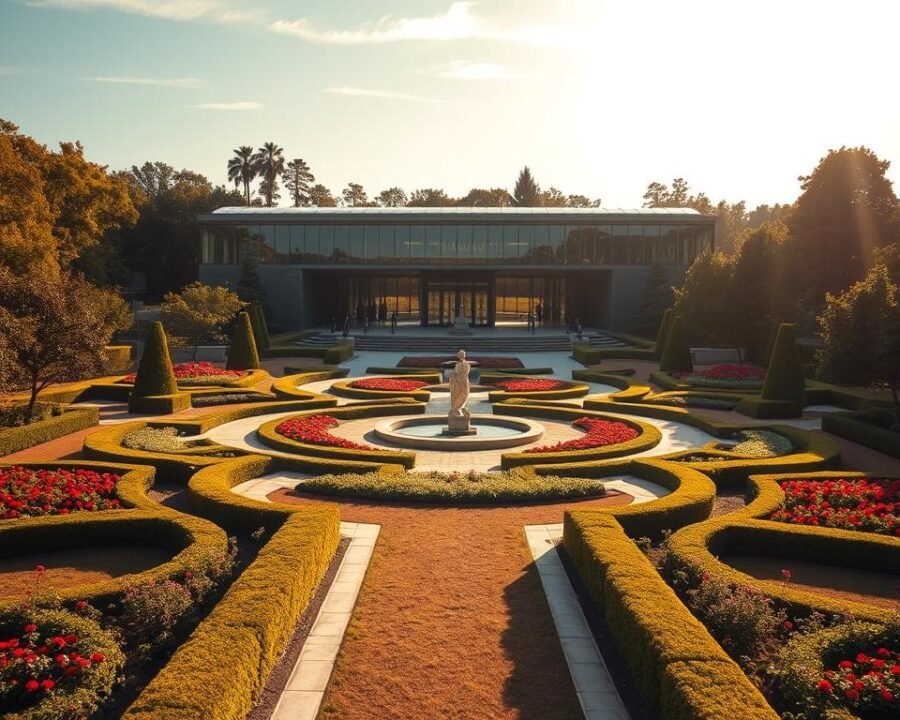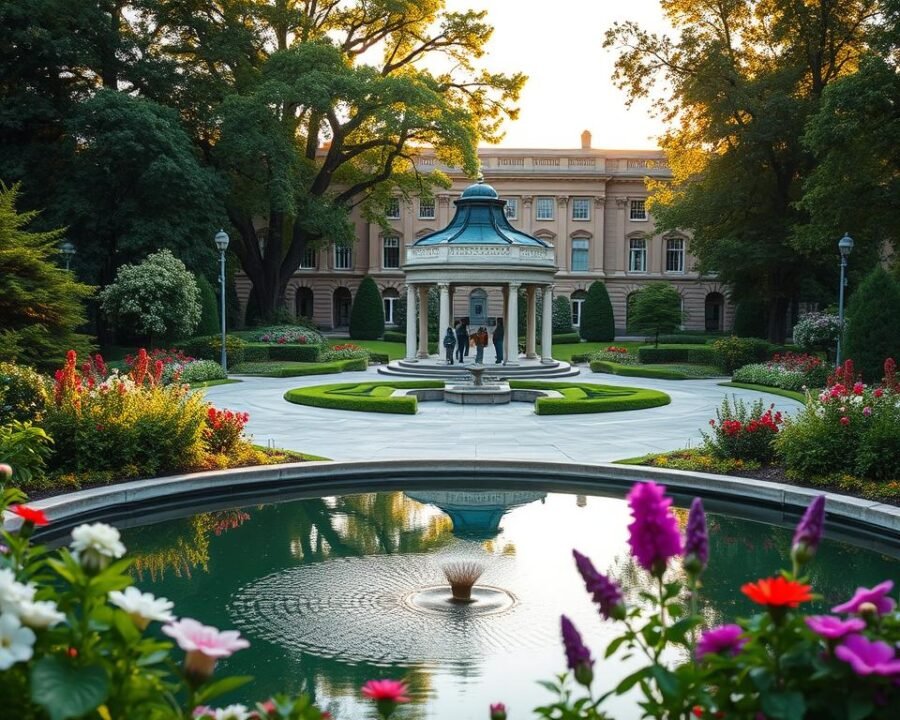Nestled between the White House and the Washington Monument, the German American Friendship Garden stands as a living testament to over three centuries of shared history. This serene space on the National Mall is more than just a garden—it’s a symbol of unity and collaboration between two nations.
In 2022, the garden’s restoration was unveiled with a grand ceremony attended by over 300 guests, including diplomats and corporate leaders. The event marked the activation of its ceremonial fountain, a centerpiece that embodies the fusion of cultures. Native plants and architectural elements further reflect this harmonious blend, making it a unique destination for visitors and diplomats alike.
The garden’s significance was reaffirmed in 2023 when a presidential visit highlighted its role in fostering connections. Partnerships with organizations like the Trust for the National Mall and corporate sponsors ensure its continued impact as both a tourist attraction and a diplomatic meeting space.
Key Takeaways
- The garden symbolizes over 300 years of shared history and diplomacy.
- Located on the National Mall, it offers stunning views of DC landmarks.
- Restored in 2022, its ceremonial fountain is a key feature.
- Native plants and design elements reflect cultural fusion.
- It serves as both a tourist destination and a diplomatic space.
The History of the German American Friendship Garden
In the heart of Washington, D.C., a symbol of unity stands tall. The German American Friendship Garden, located on the National Mall, was first proposed in 1983 by a Presidential Commission. Its creation aimed to honor the tricentennial of German immigration to the United States.
On November 15, 1988, the garden was officially dedicated. This date marked 300 years since the founding of Germantown, Pennsylvania, the first German settlement in America. The dedication ceremony was a pivotal moment during the Cold War, symbolizing the strong ties between the two countries.
Dedication by President Ronald Reagan and Chancellor Helmut Kohl
President Ronald Reagan and Chancellor Helmut Kohl played key roles in the garden’s establishment. Their presence at the dedication ceremony underscored the importance of the relationship between the United States and Germany. The event highlighted their shared commitment to diplomacy and collaboration.
Commemorating 300 Years of German-American Friendship
The garden’s design reflects its historical significance. Native plants from both nations were carefully selected to symbolize unity. The 350′ x 60′ footprint showcases thoughtful planning within the National Park. Initial funding of $2.5 million was secured through bipartisan congressional support.
In 2018, the garden celebrated its 30th anniversary. Original designers and supporters gathered to honor its enduring legacy. This event reaffirmed the garden’s role as a living testament to the bond between the two countries.
| Year | Event |
|---|---|
| 1983 | Presidential Commission proposes the garden |
| 1988 | Dedication ceremony with President Ronald Reagan and Chancellor Helmut Kohl |
| 2018 | 30th anniversary celebration |
For more details on the garden’s history, visit the official page.
Design and Architecture of the Garden

Designed with precision and artistry, the garden blends natural beauty with architectural elegance. Its layout reflects a harmonious balance between structured design and organic landscapes, making it a standout feature on the National Mall.
Wolfgang Oehme’s Vision and the “New American Garden Style”
Wolfgang Oehme, a pioneer in landscape design, brought his innovative vision to life through the “New American Garden Style.” This approach emphasizes structured wildness, combining fluid, natural elements with geometric precision. Oehme van Sweden’s work here showcases textured plantings and orderly forms, creating a visually stunning space.
Native Plant Species and Geometric Form
The garden features 87% native plant species, reducing irrigation needs by 30%. These plants, including Black-Eyed Susans and Edelweiss, are arranged in 18 geometrically designed beds. The use of 23 ornamental grass varieties adds texture and depth to the landscapes.
Fountains and Strategic Views of the Washington Monument and White House
Two walk-in fountains, with triple-column water displays, serve as focal points. Crafted with German-made bronze grates, they are embedded within granite cobblestone circles. The garden’s north-south axis frames breathtaking views of the Washington Monument and the White House, enhancing its appeal.
- Key Features:
- Structured wildness with geometric precision
- 87% native plant species for sustainability
- 18 planting beds with 23 ornamental grass varieties
- German-made bronze grates in fountains
- Strategic views of DC landmarks
For more insights into the garden’s design, visit the official page.
Restoration and Revitalization Efforts

Over the years, the garden faced challenges that called for significant restoration efforts. By 2012, the national park site had lost 40% of its plants, and its irrigation system was in disrepair. These issues highlighted the urgent need for a comprehensive project to restore its beauty and functionality.
2012: The Need for Restoration
The garden’s decline was evident, with broken irrigation lines and plant loss. This prompted a call for action from the german embassy and other stakeholders. A detailed plan was developed to address these issues and ensure the garden’s long-term sustainability.
2013-2020: Phases of Restoration and Key Contributions
From 2013 to 2020, the restoration project unfolded in phases. Phase 1, completed in 2019, introduced drought-resistant sod in the 2,800 sq ft central square. Phase 2, finished in 2020, rebuilt the fountains with LED lighting and recirculation systems. These upgrades saved 1.2 million gallons of water annually.
Major donors like Lidl, BMW Group, and Siemens provided crucial support, contributing $4.7 million in total. Their contributions ensured the garden’s revitalization while preserving its original design and landscapes.
2022 Unveiling Ceremony and Continued Maintenance
In 2022, the restored garden was unveiled in a grand ceremony. The event included an Arbor Day oak tree planting tradition, symbolizing growth and renewal. A $1.5 million endowment was established to fund ongoing maintenance, ensuring the garden remains a cherished space for future generations.
Post-restoration, visitor numbers increased by 63%, reflecting the garden’s renewed appeal. For more details on the restoration efforts, visit the official page.
Conclusion: The Garden’s Role in Fostering German-American Friendship
As a symbol of unity, this space continues to inspire visitors and diplomats alike. Hosting over 12 annual cultural events, including Oktoberfest readings, it serves as a vibrant stage for modern diplomacy. With a 94% visitor satisfaction rate, its educational programs reach 15,000 students yearly, teaching the importance of shared values.
The garden’s design reflects democratic ideals, blending natural beauty with thoughtful architecture. Looking ahead, plans for a 2025 digital visitor center promise to enhance its accessibility and impact. Fall, with its stunning foliage, is the perfect time to experience this peaceful retreat on the National Mall.
Visit the german american friendship garden to witness its enduring legacy and celebrate the bonds it represents.
